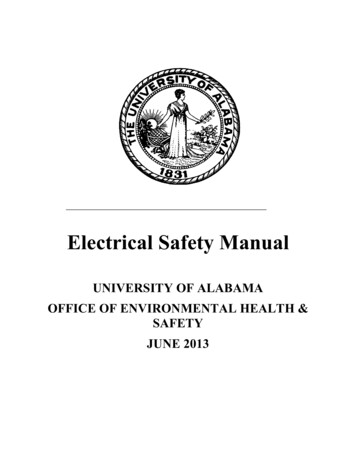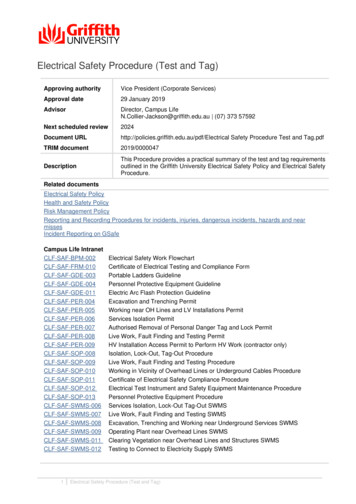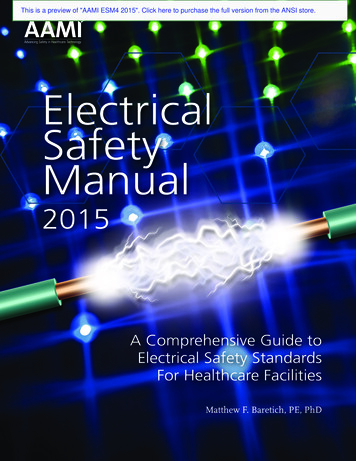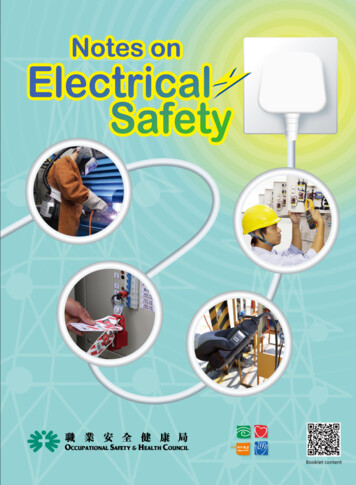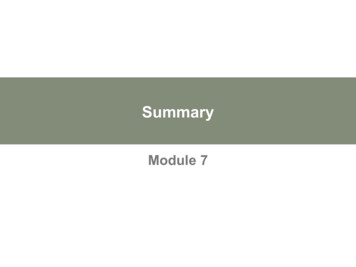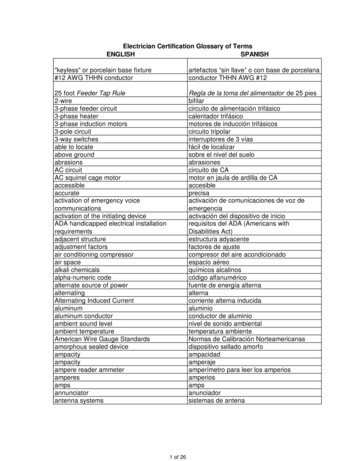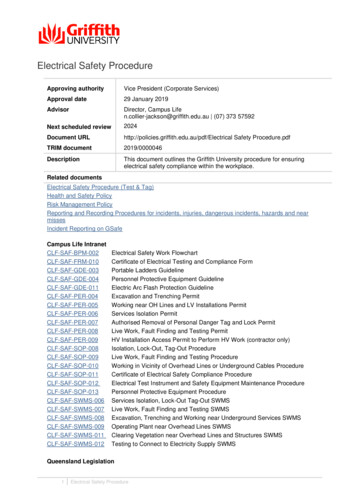
Transcription
Electrical Safety ProcedureApproving authorityVice President (Corporate Services)Approval date29 January 2019AdvisorDirector, Campus Lifen.collier-jackson@griffith.edu.au (07) 373 57592Next scheduled review2024Document URLhttp://policies.griffith.edu.au/pdf/Electrical Safety Procedure.pdfTRIM document2019/0000046DescriptionThis document outlines the Griffith University procedure for ensuringelectrical safety compliance within the workplace.Related documentsElectrical Safety Procedure (Test & Tag)Health and Safety PolicyRisk Management PolicyReporting and Recording Procedures for incidents, injuries, dangerous incidents, hazards and nearmissesIncident Reporting on GSafeCampus Life -SWMS-012Electrical Safety Work FlowchartCertificate of Electrical Testing and Compliance FormPortable Ladders GuidelinePersonnel Protective Equipment GuidelineElectric Arc Flash Protection GuidelineExcavation and Trenching PermitWorking near OH Lines and LV Installations PermitServices Isolation PermitAuthorised Removal of Personal Danger Tag and Lock PermitLive Work, Fault Finding and Testing PermitHV Installation Access Permit to Perform HV Work (contractor only)Isolation, Lock-Out, Tag-Out ProcedureLive Work, Fault Finding and Testing ProcedureWorking in Vicinity of Overhead Lines or Underground Cables ProcedureCertificate of Electrical Safety Compliance ProcedureElectrical Test Instrument and Safety Equipment Maintenance ProcedurePersonnel Protective Equipment ProcedureServices Isolation, Lock-Out Tag-Out SWMSLive Work, Fault Finding and Testing SWMSExcavation, Trenching and Working near Underground Services SWMSOperating Plant near Overhead Lines SWMSClearing Vegetation near Overhead Lines and Structures SWMSTesting to Connect to Electricity Supply SWMSQueensland Legislation1Electrical Safety Procedure
Work Health & Safety Act 2011Work Health & Safety Regulation 2011Electrical Safety Act 2002Electrical Safety Regulation 2013Queensland Codes of PracticeElectrical safety code of practice 2013 - Managing electrical risks in the workplaceElectrical safety code of practice 2010 - Working near overhead and underground electric linesElectrical safety code of practice 2010 – WorksSAIGLOBAL - Australian StandardsAS/NZS 3000:2018Electrical installations (the Wiring Rules)AS/NZS 3003:2018Electrical installations - Patient areasAS/NZS 3012:2010Electrical installations - Construction and demolition sitesAS/NZS 3017:2007Electrical installations - Verification guidelinesAS/NZS 3105:2014Approval and test specification - Electrical portable outlet devicesAS/NZS 3551:2012Management programs for medical equipmentAS/NZS 3760:2010In-service safety inspection and testing of electrical equipmentAS/NZS 4513:1995Medical Electrical Equipment - Fundamental aspects of safety standardsAS/NZS 4836:2011Safe Work: Safe working on or near low-voltage electrical installations andequipmentAS/NZS 5761:2011In-service safety inspection and testing - Second-hand electrical equipment priorto saleAS/NZS 5762:2011In-service safety inspection and testing - Repaired electrical equipmentAS/NZS IEC 60601.1:2015Medical Electrical Equipment - General Requirements for Basic Safetyand Essential PerformanceIndustry GuidelinesElectricity Hazard Guide (Live Performance Australia)Safety Guidelines for the Entertainment Industry - 24 August 2001 (Australian Entertainment IndustryAssociation and the Media Entertainment and Arts Alliance)Manufacturer’s instructions for different types of calibrated equipment[Definitions] [Purpose] [Scope] [Roles & Responsibilities] [General Requirements] [General ElectricalEquipment Survey] [Procurement of Electrical Equipment] [Design & Manufacture of Electrical Equipment][Electrical Work] [Electrical Work on Energised Electrical Equipment] [Power Outlets & Safety Switches][Specific Situations & Responsibilities] [Electrical Test Instruments] [Incident Notification & Reporting][Review of Electrical Safety Compliance] [Appendix A Guide to Labelling & Compliance Markings]1.DEFINITIONS1.1Approved Testing EntityAs per the Electrical Safety Regulation 2013 (schedule 9), an Approved Testing Entity, for a testor examination, means—2(a)a body accredited by the National Association of Testing Authorities, Australia ABN59 004 379 74 (NATA) to perform the test or examination; or(b)a body accredited by another body, operating under a reciprocal agreement with NATA,to perform the test or examination; or(c)a body approved by the regulator to perform the test or examination; or(d)a body approved to perform the relevant test or examination under a corresponding law.Electrical Safety Procedure
1.1.1Competent personCompetent person, in relation to a task, means a person who has acquired, through training,qualifications, experience or a combination of these, the knowledge and skill to carry out thetask.Note: Electrical work may only be performed by a person if the person (a)is the holder of an appropriate electrical licence authorising the work; or(b)is otherwise authorised to perform the work under the Electrical Safety Act s55(3)(d).e.g. the authorised testing of electrical equipment (test and Tag) of specified electrical equipment or hireequipmentCompetent person (Test and Tag) means:(a) a person who has the necessary practical and theoretical skills, acquired through training,qualification, experience or combination of these, to undertake correctly the required tasks,and for testing and tagging, and(b) has completed the required national competencies to be deemed competent in accordancewith AS/NZS 3760 and AS/NZS 3012, and/or(c) if the test and tag is for medical equipment, completed a course of instruction to AS/NZS3551.Note: Additional or different competencies may be required for more complex kinds of testing outside the scope ofAS/NZS 3760.1.2Dangerous Electrical EventAs per the Electrical Safety Act 2002 (s12), is any of the following:(a)(b)the coming into existence of circumstances in which a person is not electrically safe, if—(i)the circumstances involve high voltage electrical equipment; and(ii)despite the coming into existence of the circumstances, the person does not receivea shock or injury;the coming into existence of both of the following circumstances—(i)if a person had been at a particular place at a particular time, the person would nothave been electrically safe;(ii)the person would not have been electrically safe because of circumstances involvinghigh voltage electrical equipment;(c)an event that involves electrical equipment and in which significant property damage iscaused directly by electricity or originates from electricity;(d)the performance of electrical work by a person not authorised under an electrical worklicence to perform the work;(e)the performance of electrical work by a person if, as a result of the performance of thework, a person or property is not electrically safe;Examples for paragraph (e)—(f)1.3 the connection of electrical equipment to a source of supply involving incorrect polarity or other incorrectconnection the performance of electrical work as a result of which an exposed wire is left in circumstances in which itcan be energised by the operation of a switch or circuit breaker or the insertion of a fusethe discovery by a licensed electrical worker of electrical equipment that has not beenmarked as required under this Act.Duty to NotifyAs per the Electrical Safety Regulation 2013 (s265)3Electrical Safety Procedure
(a)A person who conducts a business or undertaking (PCBU) must ensure that the regulatoris notified, in a way that complies with subsections (2) to (4) and by the fastest meanspossible, immediately after becoming aware that a serious electrical incident or dangerouselectrical event arising out of the conduct of the business or undertaking has occurred.(b)The notice must be given—(i) by telephone; or(ii) in writing.1.4(c)A person giving notice by telephone must give the details of the incident or event; and ifrequired by the Regulator give written notice within 48 hours after the requirement ismade.(d)A written notice must be in a form, or contain the details, approved by the regulator.(e)A PCBU must keep a record of each serious electrical incident or dangerous electricalevent for at least 5 years.Electrical ApplianceAs per the Electrical Safety Act 2002 (Schedule 2):1.5(a)An appliance is a device that consumes electricity at a voltage greater than extra lowvoltage and in which the electricity is converted into heat, motion or another form of energyor is substantially changed in its electrical character.(b)Although a light fitting, including its bulb or tube, is an appliance, the bulb or tube, takenalone, is not an appliance.Electrical EngineerAs per the Electrical Safety Act 2002(a)a person who is a registered professional engineer under the Professional Engineers Act2002 and who is registered in the area or preserved area of electrical engineering underthat Act; or(b)a person who held a degree in electrical engineering granted by—(c)1.6(i)an approved school of engineering under the repealed Professional Engineers Act1988; or(ii)an approved faculty of engineering under the repealed Professional Engineers Act1988; before the repeal of that Act and who continues to hold the degree; ora person who held, immediately before the commencement of the Professional Engineersand Other Legislation Amendment Act 2008, and continues to hold, a qualification inelectrical engineering granted by a tertiary education institution that entitled the person tobe admitted to the Institution of Engineers Australia, as a graduate member, andtransitioning to a RPEQElectrical EquipmentAs per the Electrical Safety Act 2002 (s14)(a)means any apparatus, appliance, cable, conductor, fitting, insulator, material, meter orwire that—(i) is used for controlling, generating, supplying, transforming or transmitting electricityat a voltage greater than extra low voltage; or(ii) is operated by electricity at a voltage greater than extra-low voltage; or(iii) is part of an electrical installation located in an area in which the atmosphere presentsa risk to health and safety from fire or explosion; or(iv) is, or is part of, a cathodic protection system.4Electrical Safety Procedure
1.7Electrical InfrastructureElectrical Infrastructure includes an electrical installation, electrical equipment, electrical line orassociated equipment for an electrical line.1.8Electrical InstallationAs per the Electrical Safety Act 2002 (s15)(a)An electrical installation is a group of items of electrical equipment that—(v) are permanently electrically connected together; and(vi) can be supplied with electricity from the works of an electricity entity or from agenerating source; and(vii) do not include items that are works of an electricity entity.(b)An item of electrical equipment may be part of more than 1 electrical installation(c)In subsection (1)(a)—(i) an item of electrical equipment connected to electricity by a plug and socket outlet isnot permanently electrically connected; and(ii) connection achieved through using works of an electricity entity is not a considerationin determining whether or not electrical equipment is electrically connected.1.9Electrical RiskAs per the Electrical Safety Act 2002 (s10(1))(a) in relation to a person, the risk to the person of death, shock or injury caused directly byelectricity or originating from electricity; or(b) in relation to property, the risk to the property of—(i) damage caused by a cathodic protection system; or(ii) loss or damage caused directly by electricity or originating from electricity.1.10 Electrically SafeAs per the Electrical Safety Act 2002 (s10(2)) means,(a) for a person or property, that the person or property is free from electrical risk, and(b) for electrical equipment or an electrical installation, that all persons and property are freefrom electrical risk from the equipment or installation, and(c) for the way electrical equipment, an electrical installation or the works of an electricity entityare operated or used, that all persons and property are free from electrical risk from theoperation or use of the equipment, installation or works; and(d) for the way electrical work is performed, that all persons are free from electrical risk from theperformance of the work, and(e) for the way a business or undertaking is conducted, that all persons are free from electricalrisk from the conduct of the business or undertaking, and(f) for the way electrical equipment or an electrical installation is installed or repaired, that allpersons are free from electrical risk from the installing or repairing of the equipment orinstallation.1.11 Electrical SafetyAs per the Electrical Safety Act 2002 (s10 (3)), means a person or property is electrically safe.1.12 Energised Electrical WorkEnergised electrical work means electrical work carried out in circumstances where the part ofelectrical equipment being worked on is connected to electricity or ‘energised’ [Code of Practice2013 - Managing electrical risks in the workplace].5Electrical Safety Procedure
1.13 Electrical WorkAs per the Electrical Safety Act 2002 (s18)(a) connecting electricity supply wiring to electrical equipment or disconnecting electricity supplywiring from electrical equipment; or(b) manufacturing, constructing, installing, removing, adding, testing, replacing, repairing,altering or maintaining electrical equipment or an electrical installation.Examples of electrical work— installing low voltage electrical wiring in a building installing electrical equipment into an installation coupler or interconnector replacing a low voltage electrical component of a washing machine maintaining an electricity entity’s overhead distribution system1.14 Entertainment activitiesIncludes stage operations of any kind whether or not at an internal or external venue1.15 Entertainment venueAny place where a performance is conducted1.16 Electrical Voltage1.16.1 Extra Low Voltage (ELV)As per the Electrical Safety Act 2002 (Schedule 2 (S8) means voltage of 50V or less AC RMS,or 120V or less ripple-free DC1.16.2 Low Voltage (LV)As per the Electrical Safety Act 2002 (Schedule 2 (S8)) means voltage greater than extra lowvoltage, but not more than 1000V AC RMS or 1500V ripple-free DC1.16.3 High Voltage (HV)As per the Electrical Safety Act 2002 (Schedule 2 (S8)) means voltage greater than low voltage1.17 Free from Electrical RiskAs per the Electrical Safety Act 2002 (s10 (2)(4))(a) Electrical risk to the person or property has been eliminated, so far as is reasonablypracticable; or(b) If it is not reasonably practicable to eliminate electrical risk to the person or property, therisk has been minimised so far as is reasonably practicable1.18 Hazardous Areas(a) an explosive gas is present in the atmosphere in a quantity that requires special precautionsto be taken for the construction, installation and use of plant; or(b) a combustible dust is present, or could reasonably be expected to be present, in theatmosphere in a quantity that requires special precautions to be taken for the constructionand use of plant.1.19 Hire EquipmentA hire situation is created when the hirer provides electrical equipment, to a person or entityexternal to the hirer’s organization, which passes out of the control of the hirer. This excludesequipment that is being lent to Griffith University students/staff.1.20 Hostile Operating EnvironmentsHostile Operating Environments are those where operating conditions are likely to damage theequipment or reduce its life span. This includes conditions that expose the equipment tomoisture, heat, vibration, mechanical damage, corrosive chemicals and dust. Examples include:wet or dusty areas, outdoors, workplaces that use corrosive substances, commercial kitchens,manufacturing environments.6Electrical Safety Procedure
1.21 In Scope Electrical EquipmentAs per Electrical Safety Act 2002 (s48B),(a) In-scope electrical equipment is low voltage electrical equipment that is designed, ormarketed as suitable, for household, personal or similar use.(b) It is immaterial whether the low voltage electrical equipment is also designed or marketedto be used for commercial or industrial purposes.1.22 Management Control (of plant and equipment)In relation to plant and electrical equipment, management control includes having responsibilityfor the operation and use, testing and inspection, maintenance and repair of the electricalequipment. Control may also include responsibility for the safe installation and commissioningof the electrical equipment.1.23 Person Conducting a Business or Undertaking (PCBU)The University as a PCBU must fulfil its primary duty of care by ensuring, so far as reasonablypracticable, the health and safety of its workers and of others at risk from the work the Universitycarries out. This means anyone within the University who has management or control mustensure that work is conducted in a way that is electrically safe, and anything arising from aworkplace, are without risks to ensure the health and safety of staff students, visitors orcustomers at the workplace.A PCBU must ensure that:(a) Electrical equipment is electrically safe(b) Electrical safety of all persons and property by the electrical work performed by anoutsourced contractor(c) People performing work on or near to exposed parts are electrically safe1.24 PlantPlant includes—(a) any machinery, equipment, appliance, container, implement and tool; and(b) any component of any of those things; and(c) anything fitted or connected to any of those things1.25 Prescribed Electrical EquipmentAs per the Electricity Regulation 2006, Prescribed Electrical Equipment means an item ofelectrical equipment stated schedule 4, column 1, as defined in the relevant standard.Part 1- Equipment requiring registration and labellingPart 2 - Equipment requiring registration onlyPart 3 - Equipment requiring registration that may be labelled1.26 Primary Duty of CareThe Electrical Safety Act, provides for circumstances (the electrical safety circumstances) inwhich a primary duty of care is imposed on the University to ensure the business orundertaking is conducted in a way that is electrically safe. [ES Act s30 (1)]The duty includes ensuring:(a) all electrical equipment used in the conduct of the person’s business or undertaking iselectrically safe [Act s30(2)(a)](b) in the performance of electrical work, the electrical safety of all persons and property likelyto be affected by the electrical work [ES Act s30(2)(b)]7Electrical Safety Procedure
(c) in the performance of work (whether or not electrical work) involving contact with, or beingnear to, exposed parts, persons performing the work are electrically safe [ES Act s30(2)(c)](d) that persons who undertake electrical works are appropriately qualified and licenced [ES Acts57AA]It is the duty of an officer of a PCBU to exercise due diligence to ensure the PCBU complieswith its health and safety duties and obligations. [ES Act s38A] [WHS Act s27]The duty of workers and other persons at a workplace include taking reasonable care of theirown health and safety and that of others as well as taking reasonable care that their acts oromissions do not adversely affect other persons. Duties include complying with reasonableinstructions given by the PCBU and cooperating with any reasonable health and safety policyor procedure at the workplace. [ES Act s39-s40] [WHS Act s28-s29]1.27 Serious Electrical IncidentAs per the Electrical Safety Act 2002 (s11) is an incident involving electrical equipment if, in theincident—(a) a person is killed by electricity, or(b) a person receives a shock or injury from electricity, and is treated for the shock or injury byor under the supervision of a doctor, or(c) a person receives a shock or injury from electricity at high voltage, whether or not the personis treated for the shock or injury by or under the supervision of a doctor.1.28 Specified Electrical Equipment(a) for the performance of amusement work, manufacturing work or rural industry work, thefollowing equipment (other than an amusement device or amusement ride)—(i)a cord extension set with a current rating of not more than 20 amps;(ii)an electrical portable outlet device with a current rating of not more than 20 amps;(iii) electrical equipment, other than a portable safety switch, that—(A)has a current rating of not more than 20 amps; and(B) is connected by a flexible cord and plug to low voltage supply; and(b) for the performance of office work or service work—(i)a cord extension set with a current rating of not more than 20 amps; or(ii)an electrical portable outlet device with a current rating of not more than 20 amps; or(iii) electrical equipment, other than a portable safety switch, that—(A) has a current rating of not more than 20 amps; and(B) is connected by a flexible cord and plug to low voltage supply; and(C) is moved during its normal use for the purpose of its use.8Electrical Safety Procedure
2.PURPOSEThis procedure sets out the University’s electrical safety requirements in order to protect people andproperty from the risks associated with electricity within the university workplace. It provides generalprocesses in order to achieve those requirements.Note: where there is a conflict in requirements set out in the procedure and the legislation or a codeof practice1, the higher standard of electrical safety shall apply.In terms of electrical safety, where the Electrical Safety Act 2002 (ES Act) and the Work Health andSafety Act 2011 (WHS Act) both apply, the ES Act takes precedence. The University will also complywith subordinate legislation including the Electrical Safety Regulation 2013 and applicable ElectricalSafety Codes of Practice in the management of electrical risks.3.SCOPEThis procedure applies to all University Elements in the conduct of their business operations as wellas workers2 who in carrying out work (whether or not electrical work) for the University may come intocontact with electricity and electrical equipment within the workplace including off campus activitiesand sites. The procedure also applies to other people who may be at risk from contact with electricityand electrical equipment within the University workplace including tenants of leased premises.4.ROLES AND RESPONSIBILITIES4.1Delegated AuthorityHeads of Elements, Directors and Research Centre Directors, are responsible for general andelectrical safety in their own areas and the workplaces of their general and academic staff.Academic Heads of School, teaching staff, and all Managers including Campus Life FacilitiesManagers, are responsible for the identification, assessment and control of electrical riskexposure, to fulfil the requirements contained within this procedure.4.2Campus LifeUnder the Construction Policy, Campus Life is responsible for the construction and maintenanceof Griffith University buildings and structures including associated electrical infrastructure.Electrical infrastructure under Campus Life management control consists of electricalequipment, installations, plant, fittings and fixtures associated with a building or structure or theelectrical supply to a building or structure.As such Campus Life is responsible for ensuring that the electrical infrastructure under itsmanagement control is electrically safe and the way the electrical infrastructure is designed,installed, commissioned, maintained, used and operated is electrically safe.This includes responsibility for ensuring that the electrical infrastructure is appropriately testedand maintained and associated records are available as required.4.3University ElementsAll University elements are responsible for workplace and electrical safety of staff, students andother persons within their own areas as well as the electrical safety of electrical equipment intheir management control. Control in relation to electrical equipment, includes havingresponsibility for the operation, use, maintenance and repair of the electrical equipment.12From 1 July 2018 the status of codes of practice have been restored under legislation to require the safety measures in acode to be followed unless equal to or better than measures can be demonstratedWorkers include employees, a contractor or subcontractor, employees of a contractor or subcontractor, employees of labourhire companies, outworkers, apprentices or trainees, work experience students and volunteers [WHS Act s7]9Electrical Safety Procedure
University elements are responsible for ensuring that electrical equipment used by employeesor students are electrically safe and the workplace and electrical safety of all persons andproperty is not affected by the way the electrical equipment is designed, manufactured, installed,commissioned, maintained, used and operated. Unsafe electrical equipment is a risk to theelectrical safety of staff, students and other persons and can cause electrical damage or reducethe reliability of electrical supply.4.4Staff, Students & ContractorsAll staff, students and contractors are responsible for reporting of electrical hazards or damagedelectrical equipment. This includes inspecting for, and immediately reporting, any physicaldamage to electrical cords and equipment.5.GENERAL REQUIRMENTS5.1Management of Electrical RisksUniversity activities including the performance of teaching or research activities (whether or notelectrical work) may expose a person to electrical hazards and the risk of death, shock or otherinjury caused directly or indirectly by electricity. These activities may involve the use of electricalequipment or the performance of work involving contact with, or being near to, exposed electricalparts.Managers must ensure electrical hazards and risks are identified at a workplace in conjunctionwith workers and other relevant parties and that risk control measures to manage the electricalrisks are implemented and maintained. Examples of electrical hazards include:Electric shock arising from: contact with exposed live parts of electrical equipment or installations using faulty or damaged electrical equipment and cables using electrical equipment outdoors or in wet surroundingsRisk of fire or explosion arising from: inappropriate electrical equipment or installations being a source of ignition in hazardousatmospheres the overloading of circuits and/or overheating of equipment using heating equipmentElectrical hazards and risks are to be documented on the element operational Health and Safetyrisk register by applying the Griffith University risk assessment process.When managing electrical risks, the risks must be eliminated so far as is reasonably practicable.Where it is not reasonably practicable to eliminate risks to health and safety the hierarchy ofcontrol measures must be considered in the establishment of control measures (or combinationof the controls) for electrical and workplace safety risks.5.2Information, Training and InstructionsIn the performance of work (whether or not electrical work) that involves an electrical risk topersons or property, Managers must ensure that persons (employees, students or otherpersons) involved in or may be affected by the work activities are provided with information,training and instruction which is suitable and adequate having regards to: the nature of the work carried out, and the nature of the risks associated with the work at the time, and the control measures implemented.This includes the provision of training, Information and instruction about safe installation,operation and use of electrical equipment or an electrical installation to relevant workers or otherpersons.10Electrical Safety Procedure
Managers must ensure, so far as is reasonably practicable, that the information, training andinstruction is provided in a way that is readily understandable by any person to whom it isprovided.5.3Work carried out on or near energised electrical installations or servicesElectrical work on energised electrical equipment is prohibited unless it is testing and faultfinding work. Refer to Section 10.5.4Electrical work only to be undertaken by licenced electrical worker or authorised personManagers must ensure that persons performing electrical work are competent persons inrelation to a task. Managers must ensure a person does not perform or supervise electrical workunless the person holds a current electrical contractor licence, electrical work licence orrestricted electrical work licence, and the licence authorises the person to perform the work.Workers - for workers to undertake electrical work at Griffith University, the person must:(a) Hold a current electrical licence under the Electrical Safety Act 2002 (contractor, worker orrestricted electrical licence), and(b) Be employed by Griffith University specifically to undertake the role as: an electrician an Electrical Engineer Another trade or calling that requires limited / restricted electrical work to beundertaken in association with that trade or calling Teaching/Research staff memberTeaching/Research Staff, andorTechnicalOfficerassistingthe(c) Be trained in CPR and Switchboard Rescue requirements.(d) Be listed on the electrical worker register controlled by Campus LifeNote: Teaching, research and technical staff and/or persons holding a restricted electrical licence ARE NOT authorisedto undertake electrical work on electrical infrastructure.Contractors - for businesses contracting for the performance of electrical work, the businessmust:(a) Hold an electrical contractor, worker or restricted electrical l
As per the Electrical Safety Act 2002 (s10(2)) means, (a) for a person or property, that the person or property is free from electrical risk, and (b) for electrical equipment or an electrical installation, that all persons and property are free from electrical risk from the equipment or installation, and installation.



